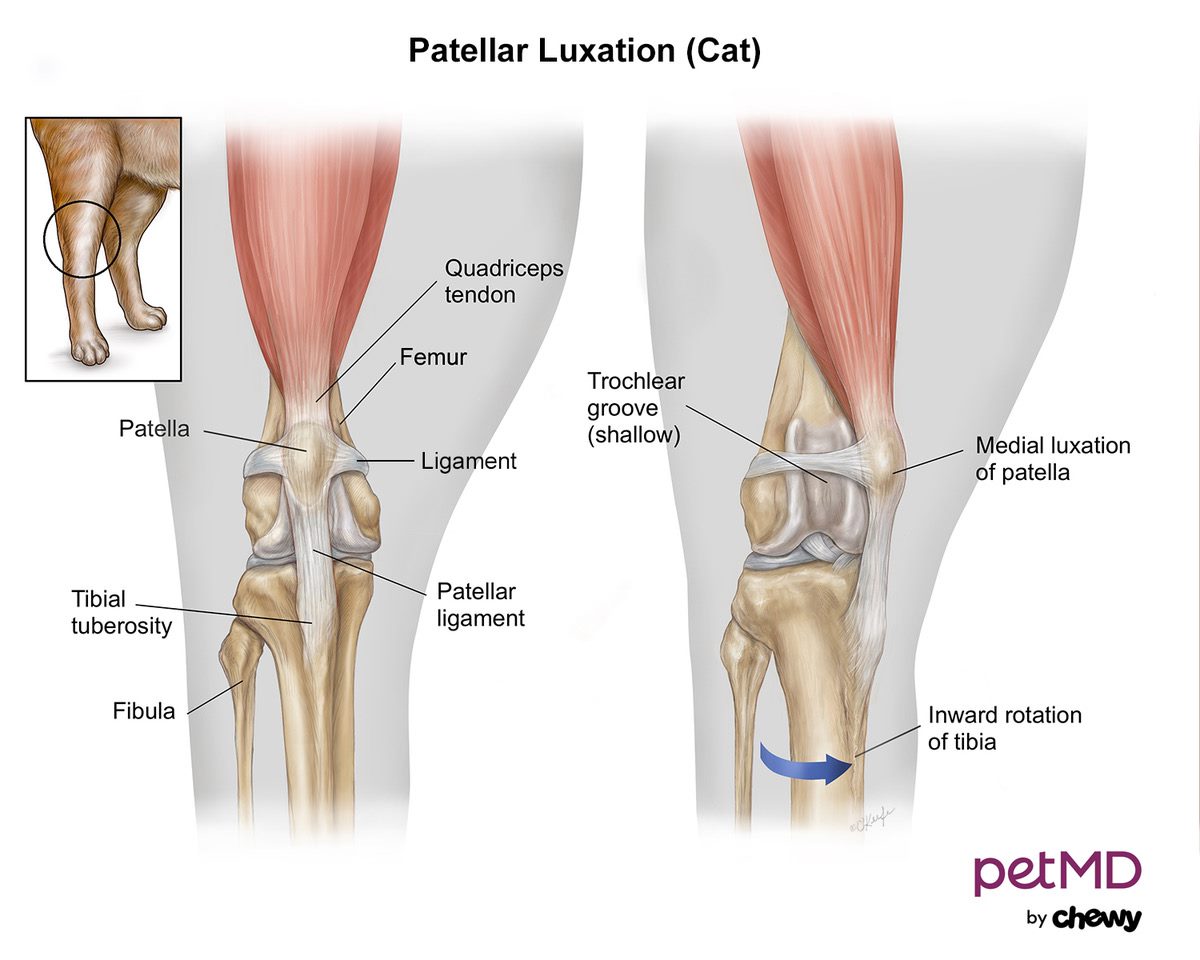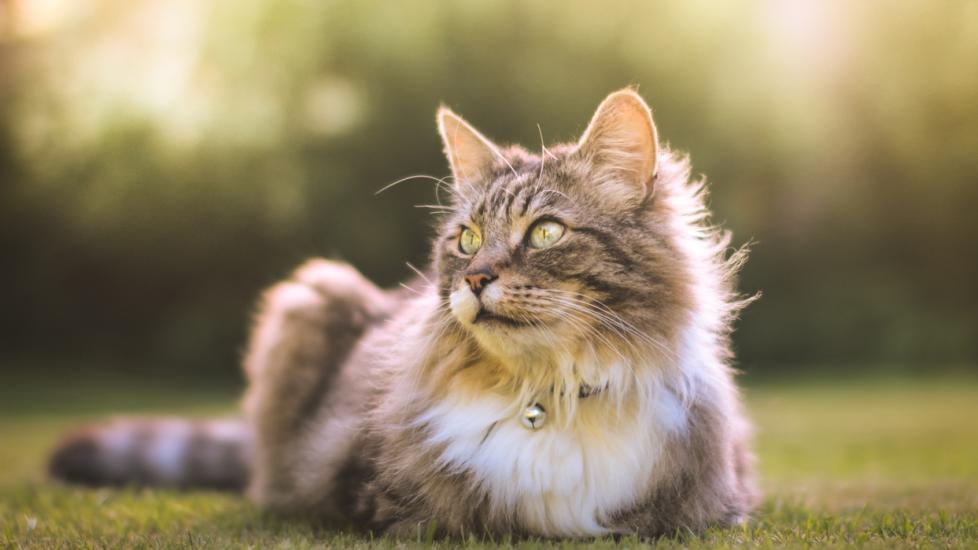Luxating Patellas in Cats
What Is Luxating Patella in Cats?
A luxating patella is a physical condition in which the kneecap, called the patella, moves out or becomes dislocated from its normal position (luxates). In people, this condition is sometimes referred to as a “trick knee.”
In cats, the knee joint is set between the thigh (femur) and the shin (tibia). The kneecap itself is an oval-shaped bone set in a deep groove called the trochlear groove at the end of the thigh.
A patella luxation occurs when the kneecap moves away (either inside or outside) from this groove. If it moves to the inside, it’s known as a medial patellar luxation (MPL). When the kneecap moves outside the groove, a vet will typically diagnose it as a lateral patellar luxation (LPL).
For either type, a luxating patella is diagnosed based on a grading system (I to IV), with the severity increasing as the grades go higher. The grades are:
- Grade I patellar luxation means that the patella can be pushed out of the trochlear groove with manual pressure but will immediately return to its original position when pressure is removed.
- Grade II patellar luxation means that the patella will sometimes move in and out of the trochlear groove on its own and only moves back to its original position when the leg is extended and rotated (most cats will do this on their own and do not need help replacing the kneecap).
- Grade III patellar luxation means that the patella is out of the trochlear groove the majority of the time but can be pushed back into the groove with manual pressure (basically the opposite of Grade I).
- Grade IV patellar luxation means that the patella is always out of the groove and cannot be replaced with manual pressure.
Over time, the kneecap’s constant movement in and out of the trochlear groove will rub away the cartilage in the joint, causing inflammation and eventually arthritis.
Arthritis causes pain and stiffness and can eventually lead to the breakdown of other vital ligaments in the knee joint, such as the cranial cruciate ligament (CCL), making the cat more prone to CCL tears.
Health Tools
Not sure whether to see a vet?
Symptoms of Luxating Patella in Cats
Symptoms of luxating patella in cats include:
-
Occasional or constant limping
-
Difficulty jumping onto things like beds and tables
-
“Skipping” on a back leg (holding it up for a few steps then replacing weight onto that leg)
As the grade of the luxation increases, so does the lameness. Cats with grades III and IV tend to show persistent lameness and, if both of their knees are affected, they can even have a bow-legged or dropped stance/crouched appearance in the back legs.
With arthritis, a cat may yowl, cry, or make other noises indicating pain or discomfort when getting up from their current position. Your cat may also be unwilling to move around, making it easy to confuse this behavior with lethargy or poor appetite, when in reality the cat is just too sore to get up, play, and eat or drink.
Causes of Luxating Patella in Cats

Patellar luxation is not common in most breeds of cats. Most patellar luxations in cats are medial, meaning the kneecap moves within the trochlear groove, and are caused by abnormalities in the cat's anatomy. In other words, they are usually due to genetics. For example, if the trochlear groove is too shallow, the kneecap has a greater opportunity to shift.
This can also occur from other abnormalities, such as if the ligaments that overlay the kneecap are off center, or if the leg bones are curved.
Injury can also cause this condition, such as from falling or other blunt force trauma. If the cause is trauma, a cat will suddenly show signs of a luxating patella. If it is caused by genetics, the onset of symptoms may be more gradual as the cat ages.
Patellar luxation (along with hip dysplasia) is seen most commonly in Abyssinians, the Devon Rex, and the domestic shorthair.
How Veterinarians Diagnose Luxating Patella in Cats
A luxating patella is typically diagnosed during physical examination by a veterinarian. Your veterinarian will massage and feel the knee and manipulate the patella to see if movement is possible. They will also monitor your cat’s gait while he walks to note any lameness or “skipping” motions.
A grade I patellar luxation is usually discovered incidentally during a cat’s regular examination, because most cats will not show any obvious signs of pain or lameness unless they have sustained an injury that causes the joint to swell.
If the luxation is chronic, the vet may detect a grating sound when palpating the affected joint.
Radiographs of the knee joint are usually taken to determine the severity of arthritis, if any, and to check for any other abnormalities. This is especially important if the luxation is due to trauma.
Treating Luxating Patella in Cats
Treating luxating patella depends on its severity, as well as the cat’s age, their clinical signs, and any other anatomical abnormalities or injuries.
Mild to moderate luxation may be treated with rest and anti-inflammatory medication while more severe cases often require surgical correction. Surgery should be considered for any cat that continually or intermittently limps, lameness that lasts over 1 to 4 weeks, or is diagnosed with a grade III or IV patellar luxation.
-
Grade I luxations may be treated with rest, anti-inflammatory medication, and similar supportive therapy.
-
Grade II luxations may require surgical correction, depending on age, other injuries, or abnormalities.
-
Grade III and IV luxations should receive surgical correction. Surgery is recommended sooner to avoid arthritis developing in the joint.
If surgery is required, a vet can deepen the grove (called trochleoplasty) to tighten the joint capsule and surrounding soft tissue to improve stability that can be used to repair a luxating patella. Other surgeries might be done to correct the patellar ligament (called tibial tuberosity transposition).
After surgery, the vet will usually suggest that the pet parent restricts exercise for at least 2 weeks, while encouraging mild activity. If the luxation requires more aggressive surgical correction, the vet may recommend 4 to 6 weeks before any exercise.
Recovering from Luxating Patella in Cats
As with treatment, recovery depends on the severity of the luxating patella. It usually involves appropriate rest as well as pain and anti-inflammatory medication, and the cat should regain full use of the leg. If arthritis has already developed in the joint, there may be intermittent soreness/pain in the leg.
-
Prognosis for grade I, the mildest type, is typically positive, even without surgery
-
Prognosis for grade II and III is typically positive although the cat may require surgical correction
-
Prognoses for grade IV and chronic luxations are guarded due to a higher likelihood of arthritis
Cats with grade IV patellar luxation (or had a previous femoral fracture or knee surgery) have a higher risk of complications.
Managing the condition for all grades may include:
-
Reducing weight
-
Non-steroidal anti-inflammatory medication (NSAIDs)
-
Pain medications (such as Gabapentin or Buprenorphine)
-
Joint supplements (glucosamine, chondroitin, omega 3/6 fatty acids) and polysulfated glycosaminoglycan (Adequan)
Be aware of your cat’s environment, especially if they seem uncomfortable or are recovering from surgery, help to avoid the stairs, and place the litter box and food/water near the cat’s sleeping area.
Luxating Patella in Cats FAQs
Is Luxating Patella in cats painful?
Luxating patella in cats can be painful if moderate to severe, or if arthritis has formed in the joint. Usually this pain can be controlled with rest and anti-inflammatory medications.
How can I help my cat with luxating patella?
Weight reduction is very important. The less weight placed on the joint, the less luxation and pain. Using joint supplements is helpful to reduce inflammation in the knee joint. If you’re concerned that your cat has a luxating patella, call your veterinarian to schedule a consultation. The sooner a patellar luxation is diagnosed and treated, the better the prognosis for full return to function on the affected leg.
Can a luxating patella correct itself in cats?
A grade I luxating patella typically occurs infrequently and is often not visible. Though they can’t correct themselves, cats often live a full life without pain or lameness. Grade II, III, and IV luxating patellas cannot correct themselves due to the underlying anatomical abnormalities.
References
-
Cornell University College of Veterinary Medicine, Feline Health Center. Luxating Patella.
-
The Merck Veterinary Manual. Patella Luxation in Dogs and Cats.
Featured Image: iStock.com/TheImaginaryDuck
Help us make PetMD better
Was this article helpful?
